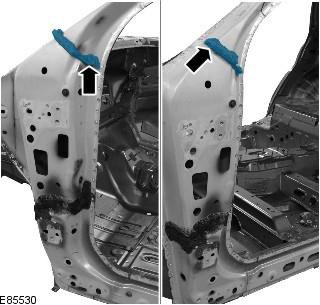CAUTION: The front section of the side panel must be welded to its reinforcement element, which contains the DP600 (duplex steel), MIG technology. Electric rivets/MIG spot welds should not be used.
NOTE: The front section of the side panel is serviced as a separate welded panel, without the wing support bracket, which is serviced separately.
NOTE: NVH elements are fixed inside this panel; they are not serviced on the new panel. If damaged, a new item will be required (s).
Removing
1. When replacing the front section of the side panel, the following items are removed:
- front bumper cover
- Front fender
- Hood
- Front door
- Backdoor
- Dashboard
- Windshield
- ceiling lining
2. For more information on this repair procedure, refer to the following sources: For more information, refer to the chapter: Body and Frame (501-26 Body Repairs - Vehicle Special Information and Approval Checks, Description and Operation) / Standard techniques used at the service station (100-00 General information, Description and principle of operation).
3. Remove the hood.
4. Remove the front fender.
5. Remove the front door. For more information, see chapter: Front door (501-03 Lockable body elements, Removal and installation).
6. Remove the back door. For more information, see chapter: Tailgate (501-03 Lockable body elements, Removal and installation).
7. Remove a covering of a ceiling. For more information, see chapter: Top trim - Vehicle not included: Tilting sunroof (501-05 Interior trim, Removal and installation) / Upper Trim - Included with the vehicle: Sunroof with tilting roof (501-05 Interior trim, Removal and installation).
8. Remove the instrument panel. For more information, please refer to the chapter: Control panel - 2.2L Duratorq - Td4 (501-12 Instrument panel and console, Removal and installation).
9. Remove the windshield. For more information, see the chapter: Windshield (501-11 Glass, frames and mechanisms, Removal and installation).
10. Remove the upper and lower door hinges from the pillar «A» (four bolts).
11. Remove the upper and lower door hinges from the pillar «IN» (four bolts).
12. Remove the counterpart of the front door lock from the rack «B».
13. Remove the top side airbag module. For more information, refer to the chapter: Curtain side airbag module (501-20B Secondary restraint system, Removal and installation).
14. Remove the rear seat cushion. For more information, see chapter: Rear seat cushion (501-10 Seat, Removal and installation).
15. Remove the left and right inner trim panels of the lower trim.
16. Remove the side impact sensor from the rack "IN". For more information, refer to the chapter: Strut Side Impact Sensor (501-20B Secondary restraint system, Removal and installation).
17. Remove the front seat belt retractor. For more information, see chapter: Front seat belt retractor (501-20A Seat belt system, Removal and installation).
18. Loosen and set aside the front section of the carpet.
19. Remove the rear section of the carpet.
20. Remove the front and rear sections of the roof molding.
21. Remove the front wheel. For more information, see the chapter: Wheel and tire (204-04 Wheels and tires, Removal and installation).
22. Remove the lower trim panel outer molding.
23. Loosen and set aside the insulating material located on the inner baffle.
24. Release and set aside the wiring harnesses on the rack «A», rack «B» and bottom trim panels.
25. Remove the wing support bracket.
- Mill three spot welds. If the support is not intended to be reused, the top spot weld should not be removed.
- Detach the support from the rack "A".
- Save the support if it is reused. If not, discard it.

26. Cut off the old panel on the rack «A» and lower trim panels, using the new panel as a template and ensuring that the new panel overlaps the panel remaining on the vehicle.

27. Cut off the old panel on the rack «B», as shown, following the dimensions shown to allow access to the rack reinforcement «B».

28. Mill out the contact welding points.

29. Disconnect the connections and remove the old panel, while also releasing the NVH elements.
Installation
1. Align the new panel and lock it in position, overlapping the old panel remaining on the vehicle. Check position alignment. If it is correct, go to the next paragraph. If not, make any necessary adjustments and recheck before continuing.
2. Cut the new and old panels on the bottom rail panel and upright «A», where it is necessary to make butt joints using MIG technology.

3. Cut new and old panels on the rack «IN», where it is necessary to make a butt joint using MIG technology.

4. Remove the new panel and the remains of the old panel.
5. Cut holes in the new panel prepared for MIG soldering.
NOTE: The MIG welding holes should be spaced according to the intervals shown in the figure. Where this is not possible due to dents in the panel, a hole should be made at the location of the original spot weld.

6. Prepare the mating surfaces of the old and new panels.
7. Replace element if necessary (s) NVH.
8. Apply glue to the NVH element on the rack «A».

9. Apply glue to the NVH element on the stand «IN».

10. Apply glue to the rack «A», as shown.

11. Position the new panel in the desired location and secure it.
12. Make tack welds for butt joints.
13. MIG solder through the holes.

14. Clean up the tack welds.
15. Make a butt joint using MIG technology in the upper area of the rack «B».

16. Make butt joints using MIG technology on the column «A» and on the bottom trim panel.

17. Clean up all welds.
18. Installation of the corresponding panels and mechanical elements is carried out in the reverse order of removal.
Comments on this article